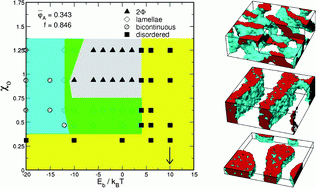Ben-Sasson, A. J. ; Avnon, E. ; Ploshnik, E. ; Globerman, O. ; Shenhar, R. ; Frey, G. L. ; Tessler, N. Patterned electrode vertical field effect transistor fabricated using block copolymer nanotemplates.
Applied Physics Letters 2009,
95, 213301.
AbstractWe report the design and implementation of a vertical organic field effect transistor which is compatible with standard device fabrication technology and is well described by a self consistent device model. The active semiconductor is a film of C(60) molecules, and the device operation is based on the architecture of the nanopatterned source electrode. The relatively high resolution fabrication process and maintaining the low-cost and simplicity associated with organic electronics, necessitates unconventional fabrication techniques such as soft lithography. Block copolymer self-assembled nanotemplates enable the production of conductive, gridlike metal electrode. The devices reported here exhibit On/Off ratio of 10(4).
Daoulas, K. C. ; Cavallo, A. ; Shenhar, R. ; Mueller, M. Phase behaviour of quasi-block copolymers: A DFT-based Monte-Carlo study.
Soft Matter 2009,
5 4499-4509.
AbstractWe develop a mesoscopic density functional theory (DFT)-based Monte-Carlo approach for studying the phase behaviour of multi-component systems comprised of irreversibly bonded, conventional macromolecules and supramolecular entities. The latter can reversibly associate with each other and the conventional components to ``living'', equilibrium polymers. The computational approach can be applied to a broad class of supramolecular systems and we focus here on quasi-block copolymer systems that contain conventional, ``dead'' AB-copolymers with a supramolecular B-terminus and supramolecular B-units. The simulations show that, by properly selecting the architecture of the ``dead'' copolymers and by varying the supramolecular association constant and the incompatibility between the segment species, A and B, one obtains a variety of different microphase-separated morphologies and macrophase separations. Two representative phase diagrams are reported as a function of the association constant, E(b), and the Flory-Huggins parameter, chi, quantifying the repulsion between A and B segments. The simulation results are qualitatively rationalised by considering the dependence of the stoichiometry on the system's parameters, and fractionation effects between coexisting phases are illustrated.

